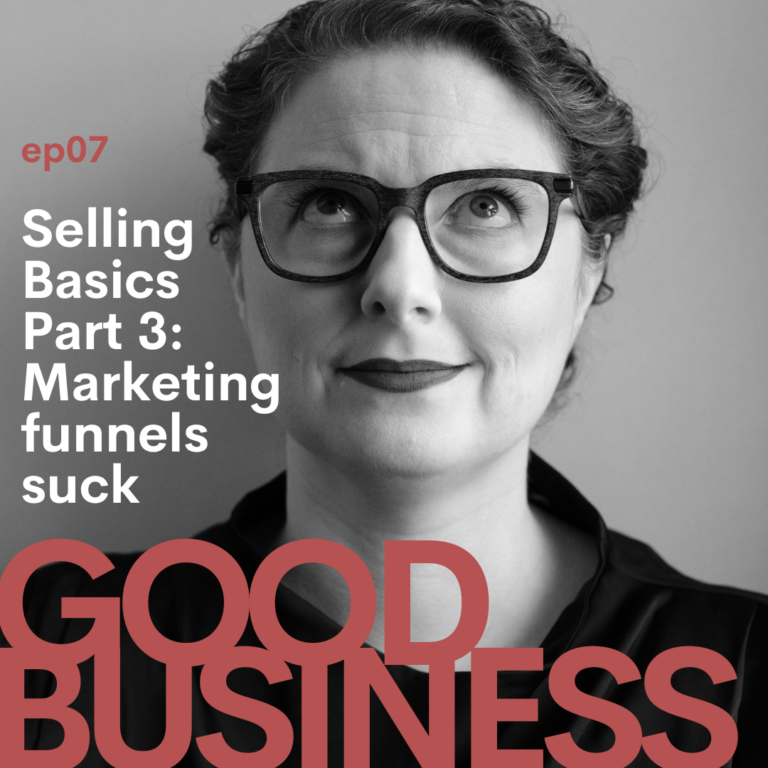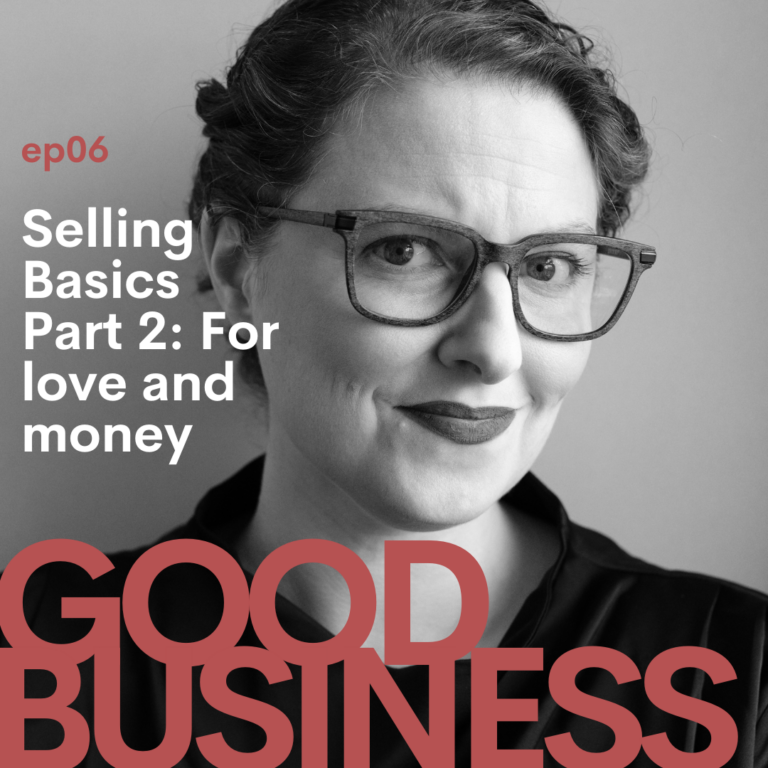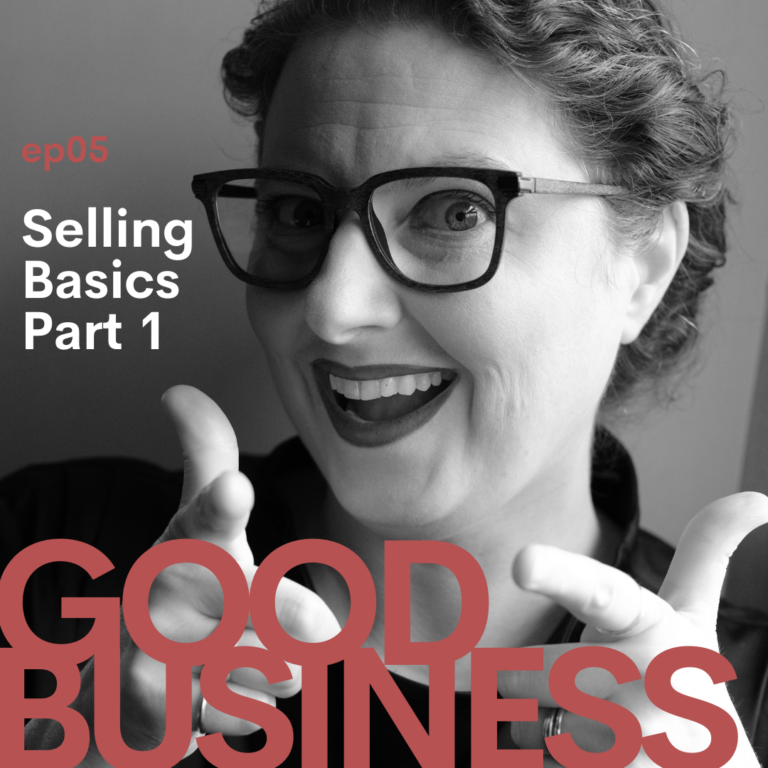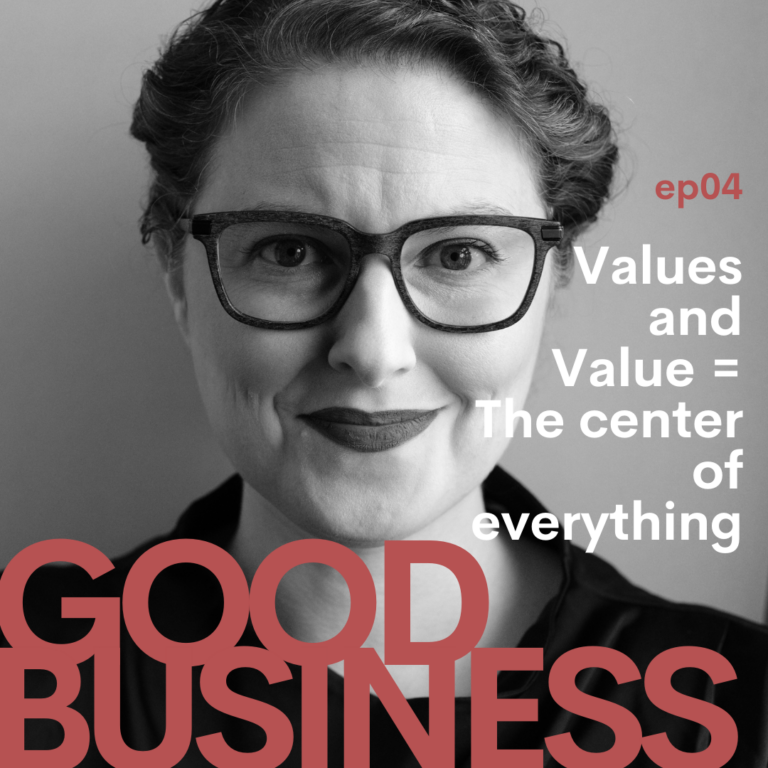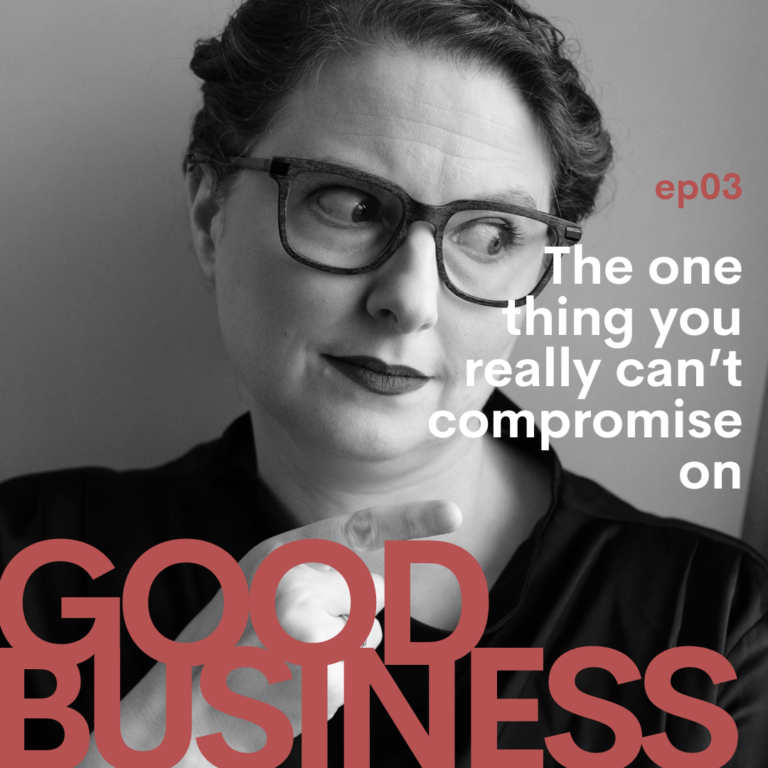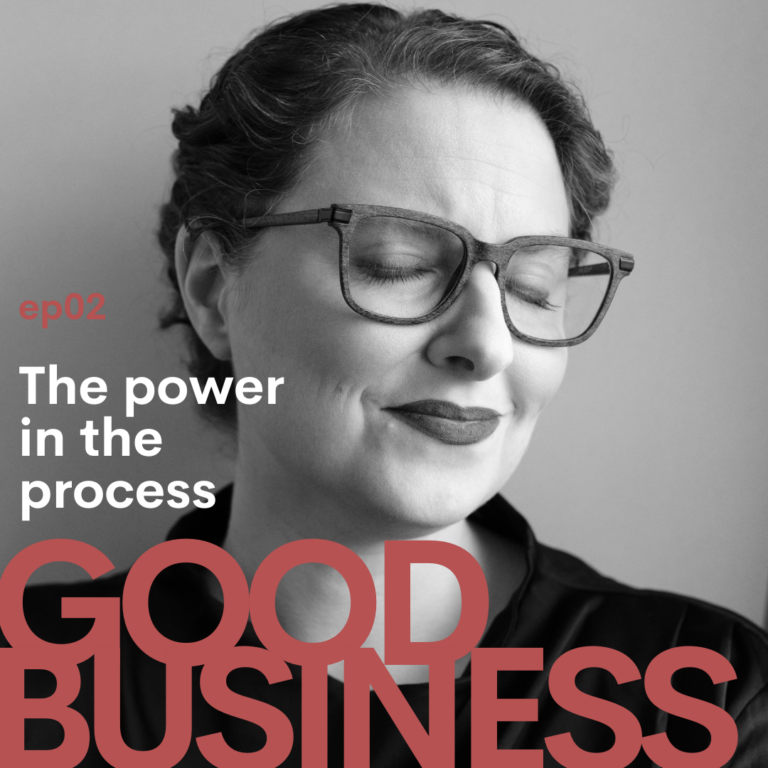This episode is the first in a series on how to do amazing consults and why it matters. The answer is not just “because it’s how you get money.” We’re using consults as a basic template. But the structural process that I’m going to lay out for you can be applied to anything from doing a job interview to interviewing a new assistant to starting any kind of relationship.
Most people approach consults like, “How can I close this as fast as possible? How can I get this person to sign on the dotted line in the most efficient way possible?”
Consults often feel like a high-pressure situation for all parties. But they don’t need to. So we’re going to talk about how to dismantle that high-pressure system and why it’s important.
Episode Transcript:
Welcome back to The Good Business Podcast. I’m your host, Illana Burk. And today we are beginning a short series on how to do amazing consults. And why they matter. And the answer is not just because it’s how you get money. We’re using consults as a basic template, but The structural process that I’m going to lay out for you, it can be applied to anything from doing a job interview to, uh, Interviewing a new assistant, to starting any relationship really. The idea here is that makes this really important, is that empathetic openers to communication is critically important to how you proceed. It sets the tone for every other part of a relationship.
And most people look at consults as, how can I close this as fast as possible? How can I get this person to sign on the dotted line in the most efficient way I possibly can?
So the impetus going in for both parties is usually riddled with anxiety. The setup is wrong. The dynamic is wrong. It’s always rushed. And the worry on both sides is really, really high. Stakes feel really, really high going in. For the person who’s attending the consult, they’re sitting there anxiously awaiting when they’re going to be sold to. For the person who’s doing the selling, they’re anxiously looking for their opening to try to do that in a somewhat natural way while they really are kind of trying to half-listen and also trying to like figure out the most organic way to sell something. And it just feels like a high-pressure situation for all parties.
So we’re going to talk about how to dismantle that and why it’s important. Today’s episode is really all to do the beginning part. Tomorrow’s episode will be all or there, our next episode will be all about the middle part. And then we’re going to talk about the closing. So this is going to be a three-part series that breaks it down really, really slowly. I really want you to absorb each step. And before you move on to the next one.
Now the way that I do consults is different than how most people do consults and it really only works for me. So I’m going to tell you how it works because it’s very unique to my structural business in how much time I offer and how, how much I give of myself on consults. When I do one for a one-on-one client. This is not a template, right? The way that I do it is not how you should do it. This is how I apply the structural principles that I’m going to lay out for you. So my consults are an hour long. Which I know sounds like a lot. Cause it is. My business is structured on having really long-term relationships with clients. I like to work with them for a long time. I like to get to know them. I need to really understand who they are and get a feel for what they’re after and why they’re there before I can feel comfortable investing as much energy and time as I do in my clients.
So for me, that length of time is a drop in the bucket. Because if I get the wrong person, and I take their money, and we get into working together, and we’re a bad fit, I’m in a whole different pile of problems. And so are they. I never want to be in a position where I feel like I have to refund somebody because we’re a bad fit. It’s my job to understand whether or not we’re a good fit before they ever get to that point.
I also don’t focus on having a large volume of clients. If you have a business model that requires a lot of people coming in the door in order to do your best work and to make a living, a lot of this model might not feel like it applies. So I’m going to do my best to, to kind of finesse what I’m talking about to apply to as many models as possible with the understanding that if you can’t apply these principles, then examining your business model is not the worst idea in the world. Because as far as I’m concerned, these are the baseline principles for how you should always move through consultations or interviews. Because it’s a functional deployment of empathy. Right. And that’s something that as far as I can tell is something that’s sorely needed. So if we make room for more of this, that means that you might have to adjust how you perform what you do. Because if you have to do a ton of consults in order to get a ton of people in the door for a very low cost or something like that, then your model might be a little bit upside down. If it doesn’t allow space for empathy.
So, how do you do an opener to a really good consult? Well, The first thing is you put people at ease. Whatever you need to do to put them at ease, this is the first step in deployed empathy. You got to understand what makes them feel anxious. For most people in any kind of consult, it’s because you have power. You have power over them. Whether you realize it or not. In my job, I’m very experienced and I’m in high demand. That means that I have power. The person sitting across from me while they’re the ones that are paying me, they really are kind of looking to me for guidance. But they’re also trying to hang on to the power of their pocketbook.
So there’s this posturing thing that happens that puts you in an immediately adversarial position. In order to have an effective consult, you need to break that down as fast as you can. I do that by putting people at ease. I tell them exactly how much time we have, why we have that much time, what we’re going to do with that time, and what they should expect about a sales pitch. So I tell them right up front. That we have an hour to spend together. We’re going to spend the beginning part just doing a little orientation. I’m going to ask a couple of questions. I’m going to do a little bit of coaching with them based on what I hear and what I understand to be true.
And then we’re going to do a little bit of time where I break down, how it works to work with me. And then I’m going to tell them to go away and think about it.
I very clearly let them know up front that they’ll be able to ask any money questions that they have. But that I’m not going to put them on the spot. In fact, I prefer them to not make a decision today. And we’ll go into that on the call where we talk about the closing, but that’s the basic cadence. That’s what I tell everybody right up front.
And again, and again, I watched their whole body relax because now they know that they don’t have to wait for a pitch. So let’s put that into a different context. Let’s say you’re interviewing a new VA.
They really, really want the job. They also really, really want you to not be a shitty boss because they’ve probably had shitty bosses in the past. That’s the basic conditions that are at play before you ever even open your mouth to talk to each other. They’re really, really hoping that you’re going to pay fairly.
They’re really, really hoping that you’re going to be understanding and flexible. And they’re really, really hoping that you’re going to like them.
So, what do you need to do right up front to put them at ease so that you can find out if they’re worth all those things? So that you can find out if you have a good connection? The first thing you would need to say is I want you to know I have X amount of time today. So we either need to move things through really efficiently. Let’s say if you only have a half an hour.
Or we have plenty of time, so we can really get to know each other. Either way set a time-based expectations so that they don’t feel like they’re worrying about looking at the clock the whole time, that they’re worrying that they might be wasting your time or you have to be someplace else. Put them at ease in a time-based way.
Next, talk about money right off the top. At least put them at ease and tell them what the pay range is for the position. In that role, that’s what they’re most worried about. They don’t want to be spending an hour, telling you how great they are only to find out that you pay 10 bucks an hour when they’re expecting a $70 an hour VA job. Yes those exist.
So, put them at ease so that they know right up front, at least with the range is. You can say something to the effect of, back to the consult model. So at the beginning, you’re going to put them at ease. You’re going to address any one of their most common concerns. And then you’re going to ask them, is there anything else that’s on your mind that concerns you before we begin that might be a deal-breaker? And you give them an opportunity to air that out. Now they know that you’ll listen because you already addressed most of what was in their head. And they’re going to feel like you’re a mind reader. And they’re going to feel like they’ve been seen and heard. Now they’re going to be really honest with you about anything that anything else that’s coming up.
You know, I’m pregnant. I might be having a baby soon. Is that going to be a problem for you? I’m really disorganized. I have a feeling that might be problematic. I’m feeling really embarrassed about it.
Whatever it is that could affect your relationship dynamic, you’re far more likely to get an honest answer to that question if you’ve already shown you’re willing to put their needs ahead of yours.
I’m looking for somebody with a lot of experience and I’d really like to pay top dollar for that. Unfortunately, I can only afford $40 an hour. If that sounds like something that’s going to be reasonable to you, then let’s proceed. If that’s much lower than you were expecting, then maybe we should end now because that’s as high as I can go right now.
Honest. Clear. Compassionate.
Then you both get to start on a level playing field. There’s nothing to be gained or lost by nickel and diming or waiting for them to undercharge. It’s a broken part of how these power dynamics work. It just fucks everything up. It puts everyone in a position to be hiding and obfuscating right from the beginning.
Do you really want a VA who’s trying to posture or hide, or do you want somebody who feels comfortable and confident in you being honest with them, so they can be honest with you?
Don’t ever put somebody who’s in a subservient position in a role to name their price. It’s a really shitty thing to do. We’ve all been in that position. Did it feel warm and fuzzy? Probably not. Don’t be that guy.
So that’s how you do the opener. You tell them how much time. You tell them what to expect from that time. You tell them the information they’re going to leave with. And you tell them what to expect as far as the pressure point of the call, that moment where they’re going to be sold to. Are you going to ask them to make a decision today? Or are you going to tell them to go away?
Are you going to tell them that, you know, if you’re hiring, are you going to tell them that you’re making a decision by the end of this meeting? Or once we’re done, I’m interviewing three more people and then I’m going to make a decision by the end of next week. And you’ll hear from me then whether or not you got the position.
Tell them exactly what kind of a person you are. Are you going to leave them hanging? Are you going to get to them whenever you feel like it? Are you going to get back to them only if they get the job? When should they expect to hear from you?
This is empathetic communication and relationship development. Anytime there’s a, a mismatch in power, meaning one of you has more than the other, all of these things are critical. The same is true when let’s say you’re having a peer to peer relationship. I just had this happen a couple of days ago. I asked for some assistance in a group that I’m in. Bunch of people offered several of those people do that for a living. But because it’s a peer based group, there’s all this like weird uncomfortable power dynamics things going on, right. Where I’m not sure if they’re offering as a friend, or if we’re going to get on the phone and I’m, and it’s actually a consult, but I don’t know that going in. So it makes me super uncomfortable because I don’t know the answer to that. The person that I decided to engage with was the one that reached out and said, Hey, I know this can be uncomfortable. I want you to know that I really think that this is just a friendly chat. And if we cross into an area where I need to charge you, I promise I’ll let you know.
Clear boundaries. Now I can go into that conversation with ease and not feeling like any minute now they’re going to send me an estimate or an invoice and I just don’t know it.
Clear boundaries, clear expectations. It’s truly a gift. And being able to do that to someone who’s about to hire you or who you’re about to hire is also modeling that leadership behavior.
thanks for joining me today. I hope you enjoyed the beginning part of our consult calls. Like I said on our next episode next week, we’re going to talk about what to do in the middle. And why it’s important. All right, everybody. Thanks a lot. Bye.
More Episodes
The Ethical Selling Part 3: Marketing Funnels Suck | GB07
Marketing Funnels. What they are (and aren’t). Why I think they’re a terrible way to structure a client relationship. And what to do instead. The idea today is to show you why and how to look deeper at the prevalent logic that you HAVE to do this to be successful. You don’t.
Selling Basics Part 2: For love and money | GB06
Today’s focus is on how to love selling by loving your clients (or potential clients) first. Loving the people you’re selling to is a HUGE part of making selling into something you adore. It’s not just an esoteric concept. It’s...
Selling the right way: Part 1 | GB05
Selling is a conversation. A communication. It’s how you show yourself to your community. The confusion happens when we see people we like, look up to, and respect using sales tactics that belie their stated mission.
Values and Value: The Center of EVERYTHING | GB04
Your values affect your your deepest work, how you make decisions, how you operate externally from yourself. It’s how you move through the world. Your value is how other’s experience it. Today’s episode is a deep-dive primer on why understanding both is critical.
The one thing to never compromise on | GB03
Business is FULL of opportunities for compromise. Options. Bad advice. The kind that tells you it’s OK to sacrifice your values. And as business owners, we are often asked to bend, shift, stretch. Change what we KNOW to be true to fit “The Rules”. Today we explore the one thing to NEVER do this on.
The Power in The Process | GB02
Process goes WAY beyond systems setup. Today, we talk about how identifying the ways in which your process is slowing your growth can be one of the most valuable exercises you can do to thrive and grow.

